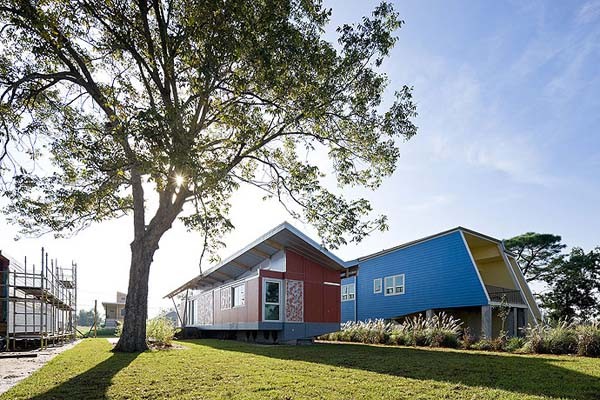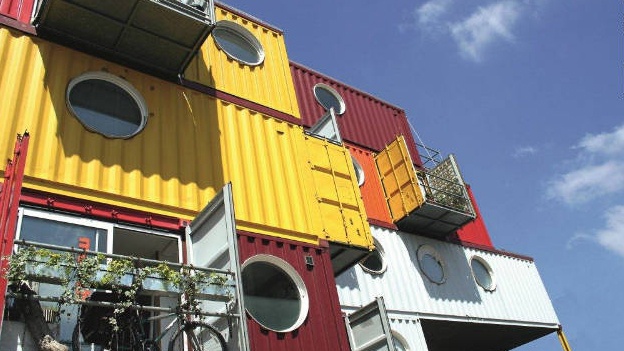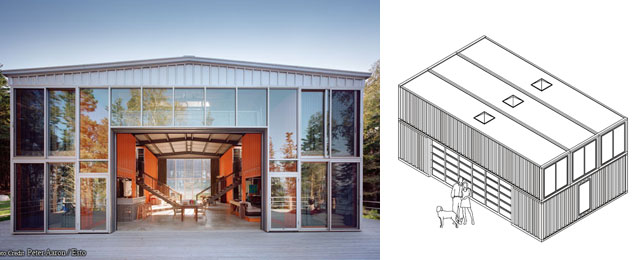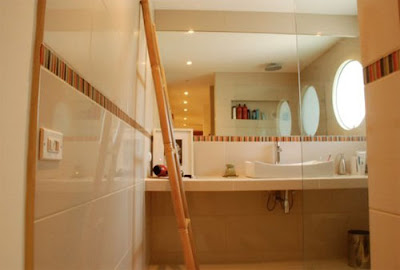Every day goods are transported from overseas in shipping containers. They begin their life in one continent then they make a long trip across the oceans to land in store shelves in a strange country. A lot of them nowadays come from Asia and since there are more goods coming to the western world than what is being shipped to Asia we are getting them by the hundreds as it is cheaper to just build a new one rather than ship them back empty and so they keep being piled up in yards, shipping docks and along rail roads. Until one day someone came out with the idea that they can be more than cargo metal boxes, they can actually become inhabited. And they are now being re-purposed. The once cargo containers are being transformed into homes, offices, studios, classrooms, retail spaces, etc.
 It is a faster way of building than conventional construction as they are already a four wall space in itself thus reducing the cost by up to 30% not including the cost of the land. The foundation is usually one the largest ticket items in a conventional building in places like Central and South America –where the building method is not based in wood frames but brick, concrete and rebars-, in the case of shipping container it can be mounted on top of concrete piers located at each corner of it; unless one lives in a quake prone city where proper measures should be taken. The side walls can be removed to later become the floor of a terrace for the story above; talk about design flexibility! Insulation is a must to make it more energy efficient. They can be used as temporary homes in the event of a natural disaster. They can be customized to ones taste, needs and budget. So the design outcome can go from a fancy home to a relatively simple one shipping container studio.
It is a faster way of building than conventional construction as they are already a four wall space in itself thus reducing the cost by up to 30% not including the cost of the land. The foundation is usually one the largest ticket items in a conventional building in places like Central and South America –where the building method is not based in wood frames but brick, concrete and rebars-, in the case of shipping container it can be mounted on top of concrete piers located at each corner of it; unless one lives in a quake prone city where proper measures should be taken. The side walls can be removed to later become the floor of a terrace for the story above; talk about design flexibility! Insulation is a must to make it more energy efficient. They can be used as temporary homes in the event of a natural disaster. They can be customized to ones taste, needs and budget. So the design outcome can go from a fancy home to a relatively simple one shipping container studio.
There is an example below on how a container can be transformed into a rad home. Shall you want us to build your home with shipping containers give us a call. We'll be happy to answer your questions.

Some detractors and nay sayers may argue they are nothing but boring boxes; cold, plain and with no flair. But that’s were ingenuity comes into action. There is a myriad of materials that can be used as cladding; wood, stone veneer, plain automotive spray paint among others. Shipping containers are modular in shape so designing with them is like playing with legos. They are built to meet international standards so a shipping container built in China is just the same in size, weight and strength as one built in Northern America.
They come in different sizes 10ft, 20ft or 40ft and even 53ft that usually are not used for sea going freight but for rail carry. A standard 40 foot dry cargo is rated to carry 58,422lbs (26,500kg) and one shipping container can withstand 8 fully loaded shipping containers on top of it; sturdy enough. They are designed to withstand harsh weather conditions and to be transported fully loaded overseas. A 40 footer provides 303 sq/ft or 29 sq/m of floor space. -For detailed specs go to: http://shippingcontainersforsale.info/
 It is a faster way of building than conventional construction as they are already a four wall space in itself thus reducing the cost by up to 30% not including the cost of the land. The foundation is usually one the largest ticket items in a conventional building in places like Central and South America –where the building method is not based in wood frames but brick, concrete and rebars-, in the case of shipping container it can be mounted on top of concrete piers located at each corner of it; unless one lives in a quake prone city where proper measures should be taken. The side walls can be removed to later become the floor of a terrace for the story above; talk about design flexibility! Insulation is a must to make it more energy efficient. They can be used as temporary homes in the event of a natural disaster. They can be customized to ones taste, needs and budget. So the design outcome can go from a fancy home to a relatively simple one shipping container studio.
It is a faster way of building than conventional construction as they are already a four wall space in itself thus reducing the cost by up to 30% not including the cost of the land. The foundation is usually one the largest ticket items in a conventional building in places like Central and South America –where the building method is not based in wood frames but brick, concrete and rebars-, in the case of shipping container it can be mounted on top of concrete piers located at each corner of it; unless one lives in a quake prone city where proper measures should be taken. The side walls can be removed to later become the floor of a terrace for the story above; talk about design flexibility! Insulation is a must to make it more energy efficient. They can be used as temporary homes in the event of a natural disaster. They can be customized to ones taste, needs and budget. So the design outcome can go from a fancy home to a relatively simple one shipping container studio.At some point in time it may had seem like a far-fetched idea to turn used and discarded shipping containers into inhabited spaces but it’s a fact that they are being put to better use and it’s being proven that it wasn’t a crazy idea after all.
They are certainly not a cookie cutter house and I think that living in a metal box is a rad and out of the box idea!
There is an example below on how a container can be transformed into a rad home. Shall you want us to build your home with shipping containers give us a call. We'll be happy to answer your questions.
ecohabitat
322 105 2856
ecohabitat4u@gmail.com
These are some examples of container homes around the world designed and built by various architects firms. You can find more info at inhabitat.com





































































































